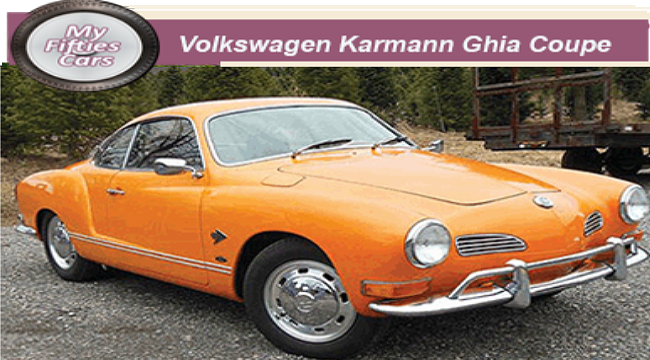
In 1956, having firmly established themselves on the market with the Type 1 (Beetle), ‘People's Car,' VW decided that the time was right to increase their market coverage with the launch of their Karmann-Ghia.
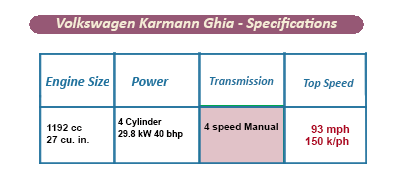
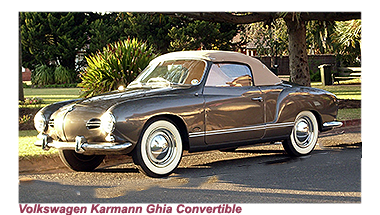 While the Beetle had played a significant part in meeting global demand for simple motoring over twenty years, the Volkswagen Karmann-Ghia was a far cry, a nippy 2+2 sports coupe and soft-top, that was a sign that the world in general and West Germany, in particular, were moving out of post-war austerity.
While the Beetle had played a significant part in meeting global demand for simple motoring over twenty years, the Volkswagen Karmann-Ghia was a far cry, a nippy 2+2 sports coupe and soft-top, that was a sign that the world in general and West Germany, in particular, were moving out of post-war austerity.
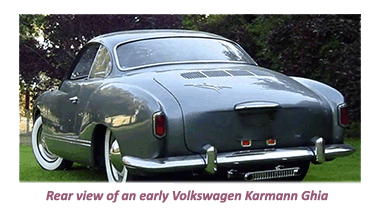 Volkswagen's senior executives recognised this and their initiative to release an alternative to the Beetle could not have been better timed.
To handle the project Volkswagen placed their faith in Karmann, better known as Wilhelm Karmann GmbH, West Germany's largest independent coachbuilders, who had worked with VW previously in the development and production of the Beetle Convertible.
Karmann employed the services of Luigi Segre a leading designer at Turin-based Ghia to handle design and development of the new Volkswagen coupe/soft top.
Volkswagen's senior executives recognised this and their initiative to release an alternative to the Beetle could not have been better timed.
To handle the project Volkswagen placed their faith in Karmann, better known as Wilhelm Karmann GmbH, West Germany's largest independent coachbuilders, who had worked with VW previously in the development and production of the Beetle Convertible.
Karmann employed the services of Luigi Segre a leading designer at Turin-based Ghia to handle design and development of the new Volkswagen coupe/soft top.
 Initially labeled the Type 14, making a concept vehicle on the Ghia stand at the 1953 Paris Motor Show, Volkswagen was encouraged by the positive reception that the new coupe received, more than sufficient to convince them to move into production.
Initially labeled the Type 14, making a concept vehicle on the Ghia stand at the 1953 Paris Motor Show, Volkswagen was encouraged by the positive reception that the new coupe received, more than sufficient to convince them to move into production.
![]()
In August 1955, the first production coupe—now renamed in honour of the three companies involved—rolled out of the factory gates. The public loved its sleek styling and sales for the first year reached five figures.
B uyers took to the Karmann Ghia more for its timeless design rather than its handling, accepting the positive factors that the car was attractively priced, bringing the dream of owning a sports car within the grasp of the ordinary person in the street.
uyers took to the Karmann Ghia more for its timeless design rather than its handling, accepting the positive factors that the car was attractively priced, bringing the dream of owning a sports car within the grasp of the ordinary person in the street.
The KarmanGhia's driving position was lower than a sedan, meaning that the Karmann Ghia was often described by the motoring press as more of a poor man's Porsche.
 Virtually in a class of its own, the Volkswagen Karmann-Ghia was unbeatable in its price class for looks, quality, and comfort.
Virtually in a class of its own, the Volkswagen Karmann-Ghia was unbeatable in its price class for looks, quality, and comfort.
Even though it didn't have anything like enough power to be classified as a real sports car, more of a touring car, while eminently affordable with readily available spare parts.
![]()
The three elements that went into the Volkswagen Karmann Ghia were almost guaranteed to make it a commercial success: the mechanical talent of Volkswagen, the coachbuilding skill of Karmann, and the futuristic design skills of Italian styling house Ghia.
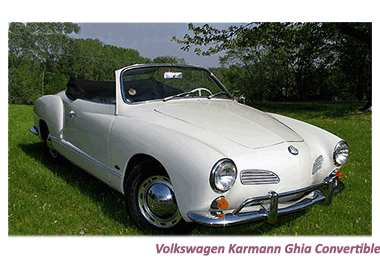 The result was a classic of automotive art, often appearing in lists of the best-looking cars of all time, the only possible fault that the Karmann Ghia has was that, despite having several upgrades from its original 1200 cc engine, it lacked the performance levels to go with the looks.
The result was a classic of automotive art, often appearing in lists of the best-looking cars of all time, the only possible fault that the Karmann Ghia has was that, despite having several upgrades from its original 1200 cc engine, it lacked the performance levels to go with the looks.
 Thanks to VW’s well-established reputation for sound engineering backed up by a famously punchy advertising campaign; the Karmann Ghia soon became a steady seller and a leading source of export income for West Germany.
Thanks to VW’s well-established reputation for sound engineering backed up by a famously punchy advertising campaign; the Karmann Ghia soon became a steady seller and a leading source of export income for West Germany.
For the close to twenty years that the Karmann Ghia was in production, VW sold around half a million of this unlikely looking coupe that flattered to deceive.


